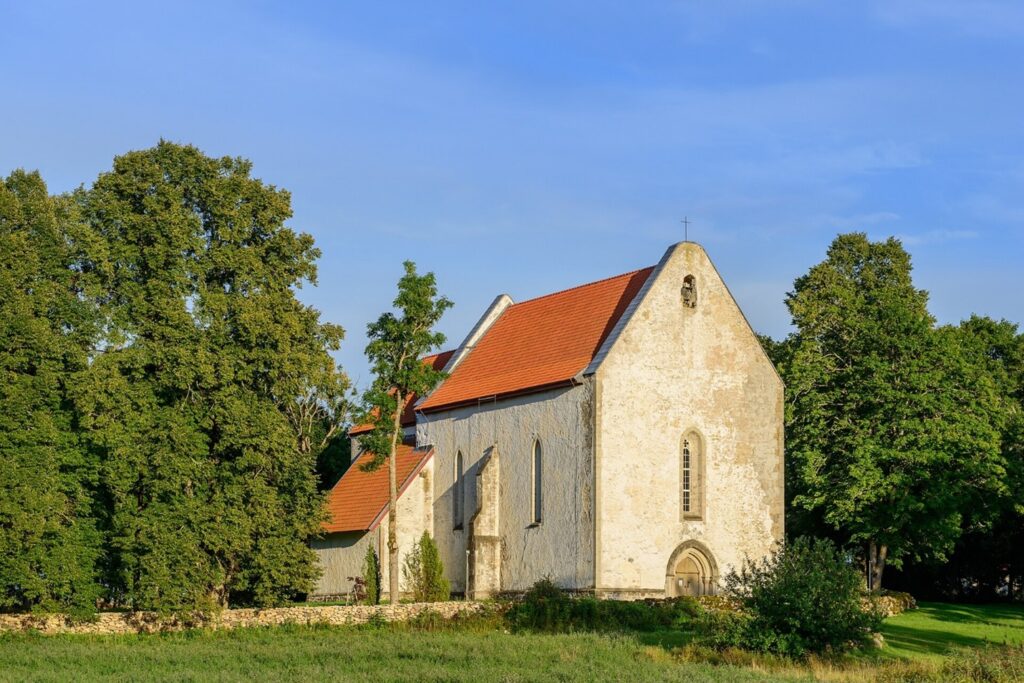
Karja Church is one of the oldest and most unique churches in Estonia, mentioned in written sources as early as 1254. It is located in the parish of the same name and is today dedicated to St. Catherine. About two kilometers northwest of the church is Karja Manor, from where the oldest Christian burials in the region from the 13th-14th centuries have been found. There may have been a private chapel or church belonging to a wealthy family who resided there, which was abandoned at the end of the 13th century.
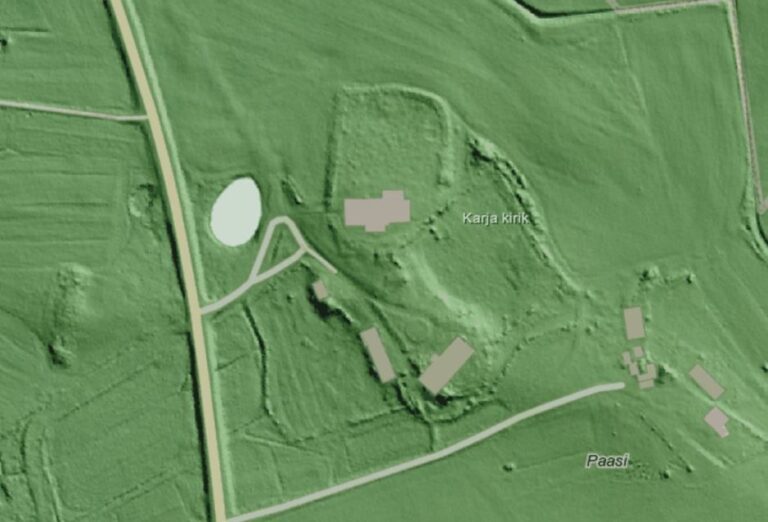
Karja Church is located on a hill that clearly stands out from the surrounding landscape. Nearby are the villages of Linnaka and Mätja, the latter of which is home to a hill called Linna- and Laevamägi (“Town- and Shiphill”), where, according to folklore, there was a harbor in ancient times and one could sail quite close to the church. The village of Linnaka, in turn, is surrounded on the east side towards the Mätja side, by an impressively high ridge (approx. 15 m above sea level). In addition, there is a noteworthy high escarpment between the church and the rectory. This is where the most magnificently decorated south portal of the church, which was recently renovated (2025), is located. Considering the location of the church in the described landscape, it is likely that the choice of location was not accidental, but that this area was already distinguished in the landscape and known to the locals, where people could gather for meetings and other gatherings via land and waterways.
The oldest known manors in the region are also located near Karja Katariina Church, on whose lands there have been large burial sites since ancient times: Koikla (1399), Roobaka (1519), Aru (1519), Ratla (1444), and Karja Manor (1527). The central location of the church in such a rich cultural landscape also points to the special significance of this place.
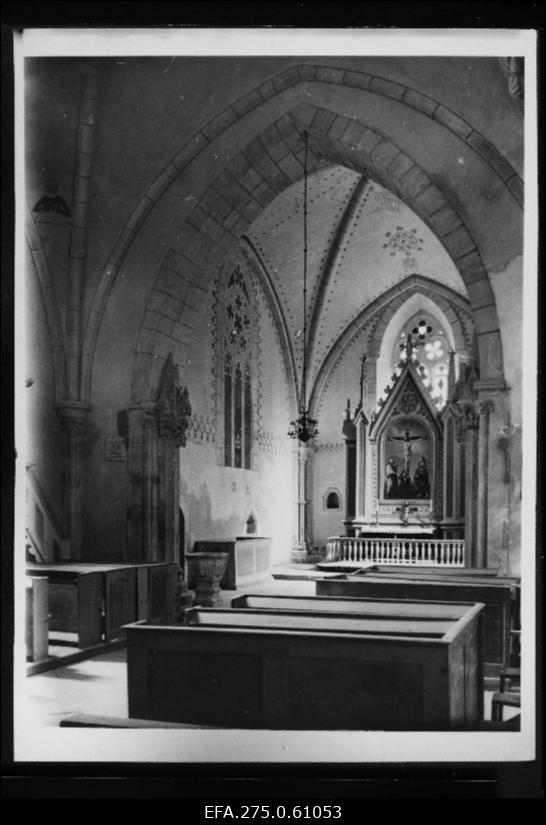
Karja Church has retained a very archaic form, that of a fortified church. The building plan is that of a single-nave longitudinal building without a tower. In the northern part of the church there is a sacristy and an old fireplace above the vault. Both the fireplace and the strong walls of the church indicate that when the church was built, the possibility of using it as a place of refuge in times of danger was also taken into account. The reason for this may have been the ongoing military conflicts in Saaremaa in the 13th century. More specifically, the plundering of the Karja area by the Teutonic Order’s troops in 1345 is mentioned in descriptions of the St. George’s Night Uprising.

Karja Church is unique for its paintings, choir stalls, and sculpture groups, which give us clues about the social and cultural conditions in Saaremaa in the 13th–14th centuries. Various researchers have pointed to the influence of Westphalia and Ojamaa in this regard. The first message to visitors to the church was provided by the aforementioned Kolgata relief above the south portal, which indicated that they were entering the kingdom of the Christian God and his son. It depicts Christ crucified, Mary and John mourning, and two thieves who were also crucified. One of the thieves is depicted as repentant, and his soul is taken to paradise by an angel, but the soul of the other, the unbelieving thief, is taken by Satan. Thus, visual language is used to make it clear to everyone what Christianity and paganism entail.
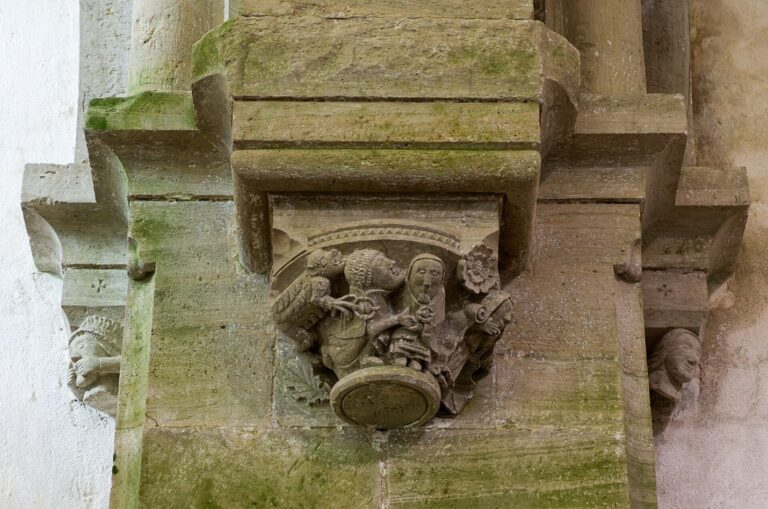
When entering through the west portal, which is where most people enter the church today, two medieval local islanders catch the eye. One of them depicts a wealthy woman wearing an exceptionally large penannular brooch and a decorated apron. Her hair is covered with a headdress, indicating that she is married. She is holding hands with a man depicted in profile, who is leaning against her. The devil is sitting on his shoulders. The purpose of the entire sculpture group may have been to explain the Christian understanding of marriage and the relationship between men and women, as well as the custom of courtship. Earlier customs must have been sufficiently different from Christian beliefs to justify such a choice of theme in the church’s relief decoration.
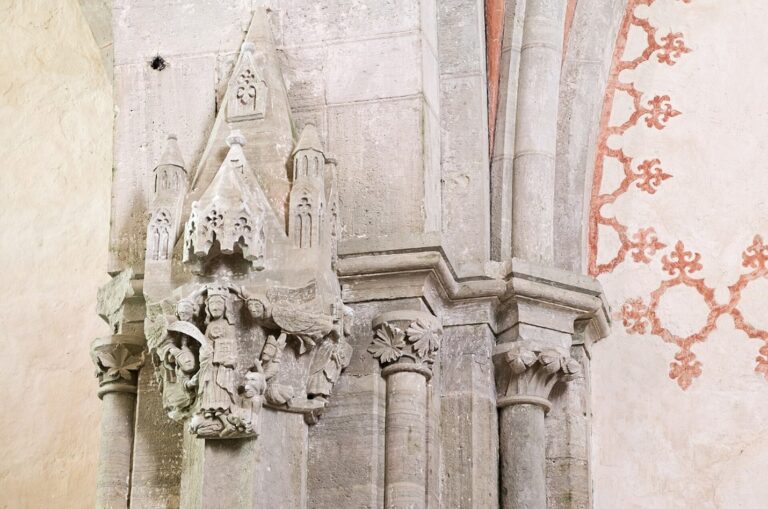
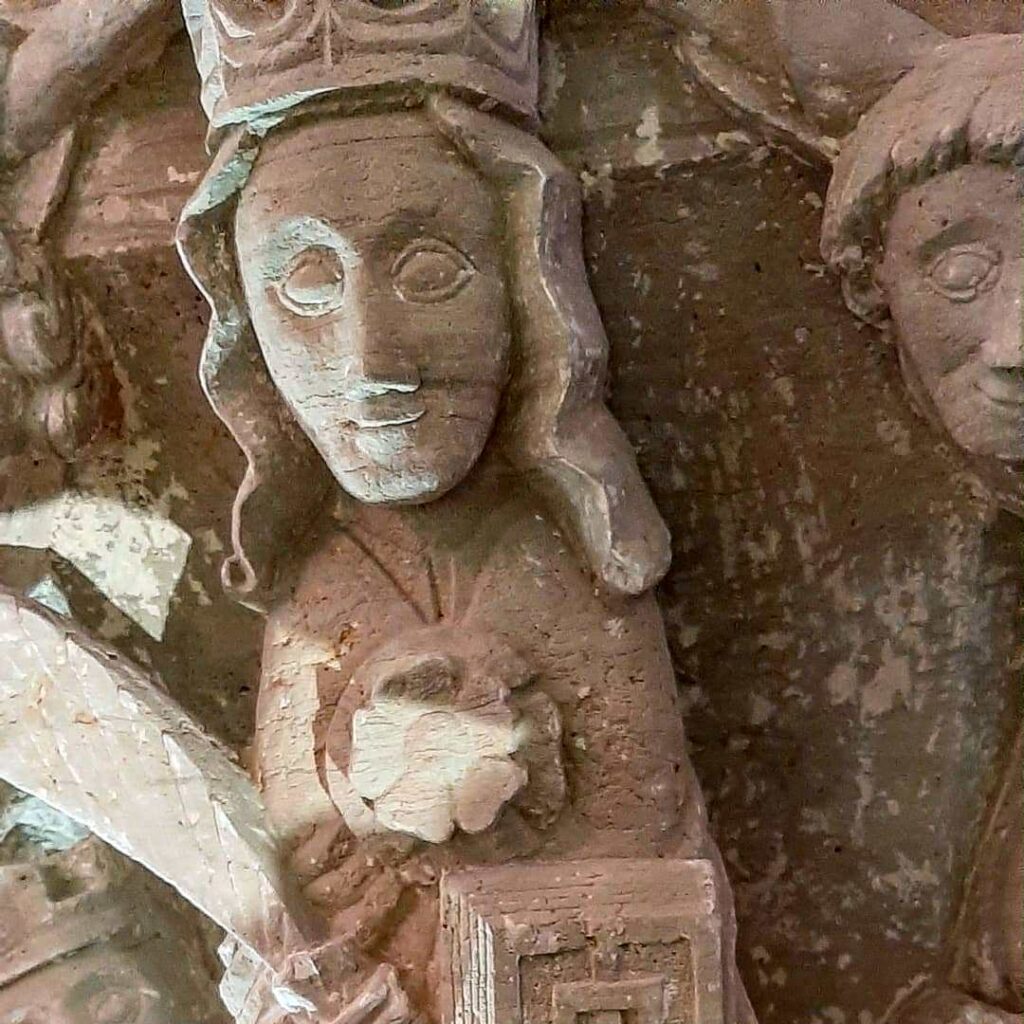

Saint Catherine and the emperor trampled under her feet in more detail. Photos by Piia Sandra Palm.
Although Karja is nowadays under the protection of St. Catherine, it is not actually known to whom it was originally dedicated. St. Catherine is depicted on the triumphal arch, but without her usual attributes, i.e., the wheel and sword. However, Peter and Paul are depicted alongside her.
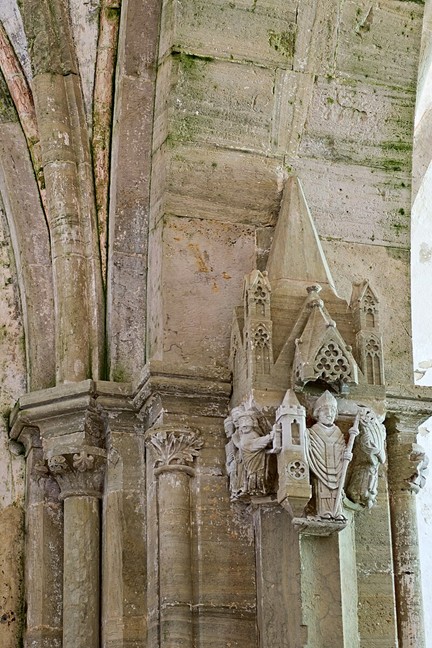
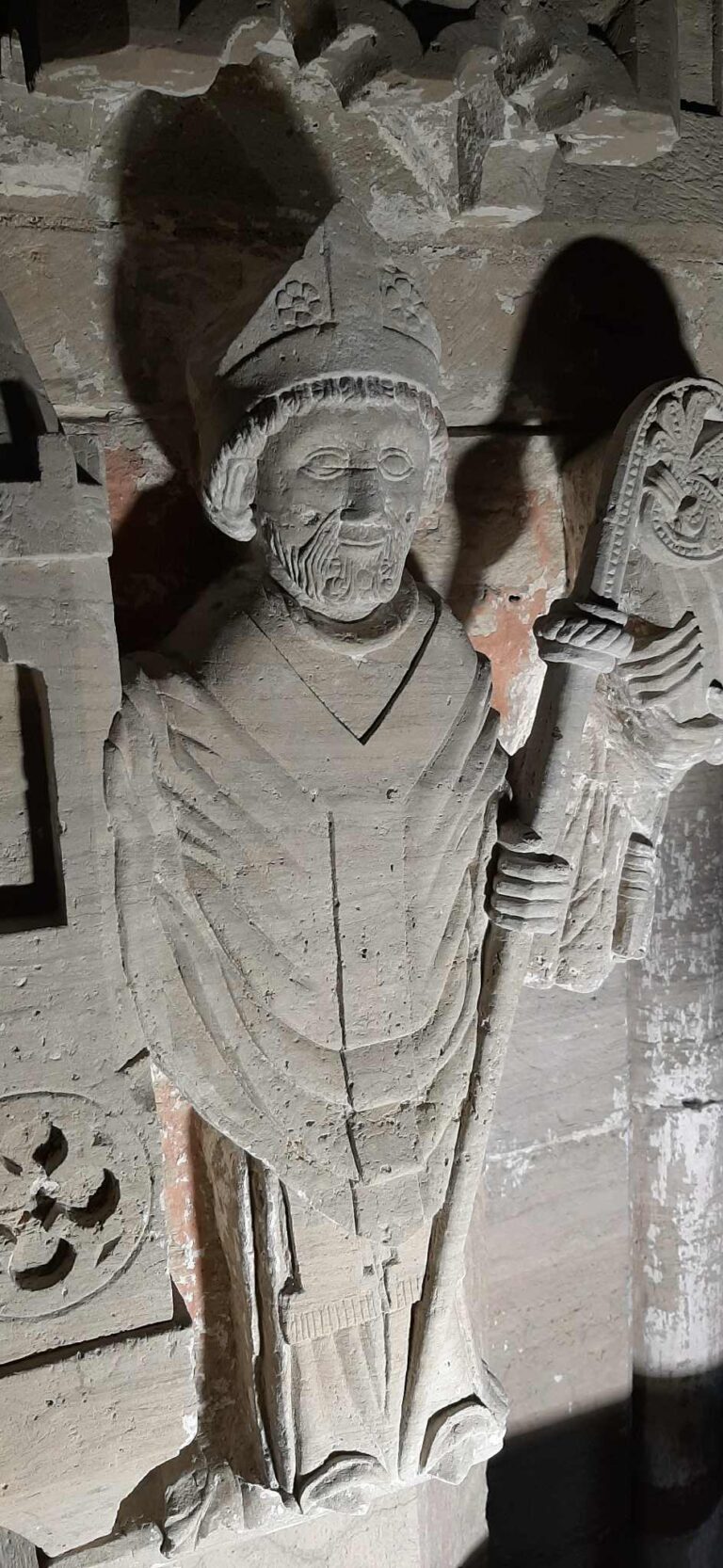
However, the triumphal arch also features a sculpture group of St. Nicholas. He was revered as the patron saint of sailors. In the documents where Karja Church is first mentioned, published on March 20 and May 13, 1254, various ports and islands were assigned to Karja parish, along with fishing rights in Soela Strait. Therefore, St. Nicholas would be a very suitable saint for the church.
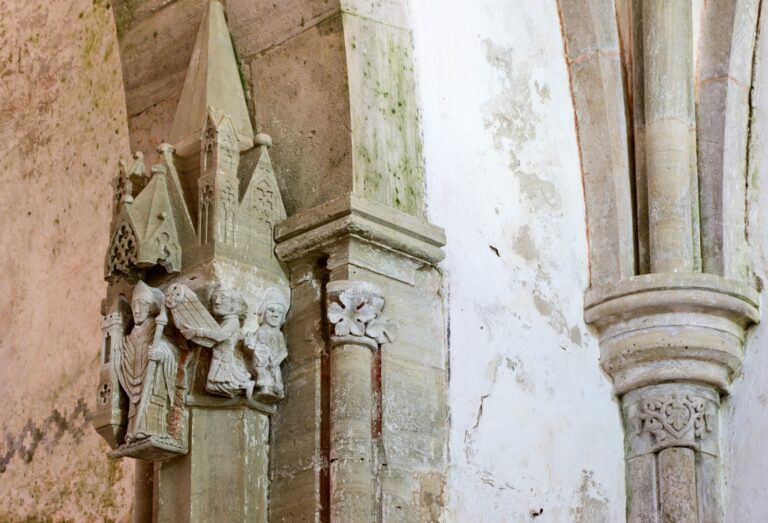
The sculpture group of St. Nicholas depicts, among other things, a man with a war club holding a small child. Such club-wielding figures have been dated to the 13th-14th centuries in Estonia, and it is possible that the figures depict a father and son. Both the man and the child wear similar headgear, probably some kind of fur hat, which has been considered characteristic of the local Estonian people.
According to legend, Saint Nicholas gave three virgins a dowry, thereby saving them from being sold into prostitution. This story is also commemorated in Karja Church, but with some local peculiarities. While dowries are usually symbolized by a bag or sometimes an apple, in Karja Church, Nicholas hands the girls a flat box-like object. Traces of what is likely a flat wooden box containing jewelry and metal-decorated clothing, and in one case a dagger, have also been found in some of the 13th-century female graves excavated near Valjala Church. It is not impossible that such boxes symbolized dowry in both funerals and church figures.

The ceiling of the choir room features eye-catching vault paintings surrounding the keystone, which have been considered pagan or ancient symbols of ownership, however, all carry meaning in the Christian system: intertwined squares, a tripod, a devil, a pentagram, and the Star of the Virgin Mary. Parallels can be found in the churches of Ojamaa, where so-called paradise vaults can be found. Based on the location of the paintings, it can be assumed that they were completed at the same time as the rest of the choir, with which they form a unified message, and were therefore already present in the church’s earliest iconographic program. During the Reformation, they were covered with a layer of lime, but were rediscovered during restoration work carried out by Hjelge Kjellin in 1923-1925.

The dating of Karja Church is based primarily on its baptismal stone. It is small in size and characteristic of the first half of the 14th century.


